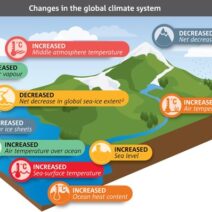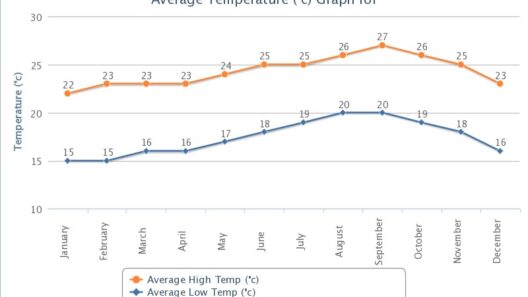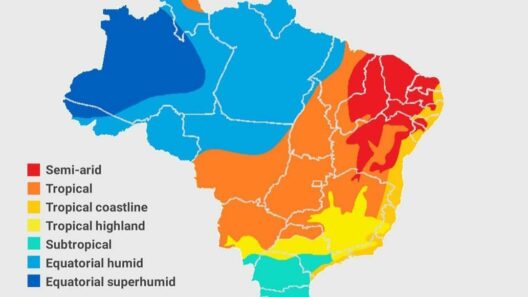Kenya, a jewel of East Africa, is renowned for its diverse ecosystems, breathtaking landscapes, and abundant wildlife. The climate in Kenya varies remarkably across its different regions, influenced by altitude, geography, and seasonal weather patterns. Understanding the intricacies of Kenya’s climate is paramount for appreciating the country’s natural beauty and the flora and fauna that thrive within it.
At its core, Kenya experiences two main seasons: the wet and the dry. The wet season typically occurs from March to May and again from October to December. During these months, the atmosphere is saturated with moisture, leading to heavy rainfall, especially in the coastal and western regions. Conversely, the dry season stretches from June to September, characterized by lower humidity and scant precipitation. This seasonal rhythm intricately shapes the lush landscapes and arid terrains that appear throughout the country.
The climate is not homogeneous, of course. One cannot overlook the profound impact of altitude on weather patterns in Kenya. The coastal regions, such as Mombasa, experience a hot and humid climate with average temperatures hovering around 80°F (27°C) year-round. Here, the Indian Ocean influences the weather, bringing warm temperatures and significant moisture. Coastal breezes provide a modicum of relief from the heat, inviting both tourists and locals to revel in the vibrant marine ecosystem.
As one travels inland to the central highlands, a dramatic transformation occurs. This region houses the renowned Mount Kenya, Africa’s second-highest peak, where temperatures can drop significantly. The highland climate is temperate, marked by cooler temperatures that can dip to around 50°F (10°C) at night. The altitudes, often exceeding 8,000 feet (2,400 meters), lead to distinct microclimates that support a rich tapestry of biodiversity. The highlands are cloaked in coffee and tea plantations, nourished by consistent rain and fertile volcanic soil.
Moreover, the Great Rift Valley, cutting through the country, introduces yet another layer of climatic diversity. This geological marvel features sweeping vistas and lakes, along with varying temperatures. The valley experiences a semi-arid climate, interspersed with areas of lush greenery. The remarkable contrast provides a habitat for numerous species, from flamingos at Lake Nakuru to the iconic wildlife in Maasai Mara.
The interplay of these microclimates drives a unique range of environments that make Kenya so captivating. One cannot discuss Kenya’s climate without acknowledging the significance of the “long rains” and “short rains.” The long rains, occurring in April and May, are typically more intense, replenishing water sources and supporting agriculture. Conversely, the short rains, occurring in November and December, while lighter, are crucial for the survival of various wildlife species during the dry months. This cyclical pattern ensures that ecosystems remain functional and resilient, illustrating the intricate balance of nature.
Perhaps one of the most striking aspects of Kenya’s climate is the phenomenon of droughts and floods, which appear to be intensifying with climate change. Extended dry spells lead to severe water shortages, impacting both agriculture and wildlife. In stark contrast, heavy rains can result in flooding, disrupting ecosystems and human settlements alike. This duality creates a layer of complexity as communities adapt to these climatic extremes, implementing innovative solutions to sustain their livelihoods amid the challenges they face.
Kenya is not only a symphony of breathtaking landscapes but also holds a vibrant tapestry of wildlife that has adapted to its climatic variances. The country’s famous national parks, including Amboseli, Tsavo, and Nakuru, teem with life, showcasing the intricate relationship between species and their environment. The migration of wildebeest across the Serengeti and Maasai Mara, for instance, is a testament to the profound influence of climatic conditions on animal behavior and survival.
Yet, the fascination with Kenya’s climate extends beyond mere observation of its flora and fauna. One becomes acutely aware of the interconnections within the ecosystem and the urgent need to address the environmental challenges threatening it. Climate change impacts, such as rising temperatures and unpredictable weather patterns, jeopardize not only wildlife but also the very livelihoods of the communities that depend on agriculture and tourism for their sustenance.
The response to these challenges has sparked innovation in conservation efforts, showcasing the resilience of both nature and the Kenyan people. Initiatives like reforestation, sustainable agriculture, and eco-tourism seek to mitigate the adverse effects of climate change while fostering an appreciation for the unique Kenyan landscape. These grassroots movements highlight the necessity of holistic approaches to environmental stewardship, emphasizing that the preservation of this magnificent country relies on the collective efforts of all stakeholders.
In conclusion, Kenya’s climate is as multifaceted as its landscapes. From the humid coastal breezes to the temperate highlands and semi-arid rift valleys, each region plays a vital role in creating a rich biodiversity that continues to be a source of wonder. While the intrinsic beauty captivates, it also beckons a deeper understanding of the ecological dynamics at play. As the world reels under the looming specter of climate change, Kenya stands at a crossroads, where the actions taken today will irrevocably influence the narratives of this exceptional land for generations to come.








